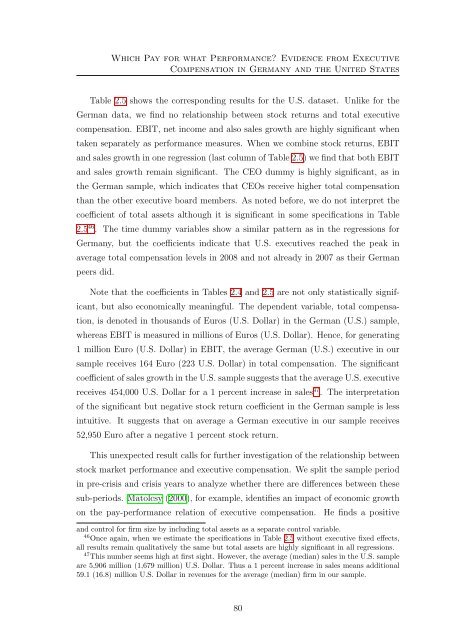Three Essays on Executive Compensation - KOPS - Universität ...
Three Essays on Executive Compensation - KOPS - Universität ...
Three Essays on Executive Compensation - KOPS - Universität ...
Create successful ePaper yourself
Turn your PDF publications into a flip-book with our unique Google optimized e-Paper software.
Which Pay for what Performance? Evidence from <strong>Executive</strong><br />
Compensati<strong>on</strong> in Germany and the United States<br />
Table 2.5 shows the corresp<strong>on</strong>ding results for the U.S. dataset. Unlike for the<br />
German data, we find no relati<strong>on</strong>ship between stock returns and total executive<br />
compensati<strong>on</strong>. EBIT, net income and also sales growth are highly significant when<br />
taken separately as performance measures. When we combine stock returns, EBIT<br />
and sales growth in <strong>on</strong>e regressi<strong>on</strong> (last column of Table 2.5) we find that both EBIT<br />
and sales growth remain significant. The CEO dummy is highly significant, as in<br />
the German sample, which indicates that CEOs receive higher total compensati<strong>on</strong><br />
than the other executive board members. As noted before, we do not interpret the<br />
coefficient of total assets although it is significant in some specificati<strong>on</strong>s in Table<br />
2.5 46 . The time dummy variables show a similar pattern as in the regressi<strong>on</strong>s for<br />
Germany, but the coefficients indicate that U.S. executives reached the peak in<br />
average total compensati<strong>on</strong> levels in 2008 and not already in 2007 as their German<br />
peers did.<br />
Note that the coefficients in Tables 2.4 and 2.5 are not <strong>on</strong>ly statistically significant,<br />
but also ec<strong>on</strong>omically meaningful. The dependent variable, total compensati<strong>on</strong>,<br />
is denoted in thousands of Euros (U.S. Dollar) in the German (U.S.) sample,<br />
whereas EBIT is measured in milli<strong>on</strong>s of Euros (U.S. Dollar). Hence, for generating<br />
1 milli<strong>on</strong> Euro (U.S. Dollar) in EBIT, the average German (U.S.) executive in our<br />
sample receives 164 Euro (223 U.S. Dollar) in total compensati<strong>on</strong>. The significant<br />
coefficient of sales growth in the U.S. sample suggests that the average U.S. executive<br />
receives 454,000 U.S. Dollar for a 1 percent increase in sales 47 . The interpretati<strong>on</strong><br />
of the significant but negative stock return coefficient in the German sample is less<br />
intuitive. It suggests that <strong>on</strong> average a German executive in our sample receives<br />
52,950 Euro after a negative 1 percent stock return.<br />
This unexpected result calls for further investigati<strong>on</strong> of the relati<strong>on</strong>ship between<br />
stock market performance and executive compensati<strong>on</strong>. We split the sample period<br />
in pre-crisis and crisis years to analyze whether there are differences between these<br />
sub-periods. Matolcsy (2000), for example, identifies an impact of ec<strong>on</strong>omic growth<br />
<strong>on</strong> the pay-performance relati<strong>on</strong> of executive compensati<strong>on</strong>.<br />
He finds a positive<br />
and c<strong>on</strong>trol for firm size by including total assets as a separate c<strong>on</strong>trol variable.<br />
46 Once again, when we estimate the specificati<strong>on</strong>s in Table 2.5 without executive fixed effects,<br />
all results remain qualitatively the same but total assets are highly significant in all regressi<strong>on</strong>s.<br />
47 This number seems high at first sight. However, the average (median) sales in the U.S. sample<br />
are 5,906 milli<strong>on</strong> (1,679 milli<strong>on</strong>) U.S. Dollar. Thus a 1 percent increase in sales means additi<strong>on</strong>al<br />
59.1 (16.8) milli<strong>on</strong> U.S. Dollar in revenues for the average (median) firm in our sample.<br />
80
















